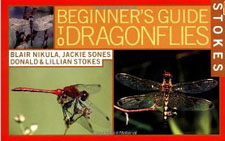Resources for Identifying Odonates
 You can get
started identifying dragonflies and damselflies with very little equipment. Naturally
the most important thing to have is a guide for identification. Many species may
be identified with the naked eye but close-focus binoculars may let you get a better
view. Some species, however, require capturing and examining appendages through
a hand lens. A good source used for the purchase of nets and hand lenses has been
BioQuip.
You can get
started identifying dragonflies and damselflies with very little equipment. Naturally
the most important thing to have is a guide for identification. Many species may
be identified with the naked eye but close-focus binoculars may let you get a better
view. Some species, however, require capturing and examining appendages through
a hand lens. A good source used for the purchase of nets and hand lenses has been
BioQuip.
Collecting
Although many people just enjoy observing and identifying odonata, specimen collection
is an important part of scientific research. Specimens in private collections should
be known and made available to other researchers. As with other outdoor activities,
there are some ethical considerations for collecting odonata. If
you are intersted in collecting and preserving odes, this article gives you all the particulars about the preparation
of specimens.
Field Guides
In the past 10 - 15 years a number of field guides to dragonflies and damselflies
have been published. Following are some recommendations for our area. Most are available
in your local bookstore or through Amazon.
 Dragonflies and Damselflies of the East
Dragonflies and Damselflies of the East (Princeton
Field Guides) by Dennis Paulson (Dec 2011)
This recently published field guide provides much critical detail to differentiate
species found in North America. It is a "must have" to get started on
field identification.
 Dragonflies of the North Woods
Dragonflies of the North Woods by Kurt Mead (Jul
2009)
While the north woods country has a number of species which do not reach Iowa, this
book has many photos and great identification clues for most of our species.
 Damselflies of the North Woods
Damselflies of the North Woods (North Woods Naturalist
Guides) by Robert Dubois (Jun 2005)
Apparently out-of-print and pricey on the secondary market, watch for this
superb field guide to damselflies at book sales. This guide, like its dragondfly counterpart,
is regionalized for the north woods but has many Iowa species.
 Stokes Beginner's Guide to Dragonflies
Stokes Beginner's Guide to Dragonflies by Blair
Nikula, Jackie Sones, Donald Stokes and Lillian Stokes (May 2002)
Although the Stokes beginner's guide somewhat targets a larger population of the
northeast, it has many Iowa species illustrated and described.
More Technical References
- Dragonflies: Behavior and Ecology of Odonata. Corbet, Philip S.1999. Cornell University
Press, Ithaca, NY.
- The Dragonflies of North America. Needham, James G., Minter S. Westfall, Jr., and
Michael May 2000. 939 pages. 24 color plates. $110. Scientific Publishers.
- Damselflies of North America. Westfall, Minter J. and Michael May. Scientific Publishers.
1996.
Useful Websites